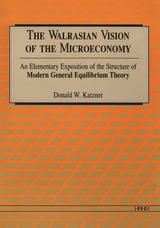2 books by Katzner, Donald W.

Time, Ignorance, and Uncertainty in Economic Models
Donald W. Katzner
University of Michigan Press, 1998
Emerging from the tradition of Marshall, Knight, Keynes, and Shackle, Time, Ignorance, and Uncertainty in Economic Models is concerned with the character of formal economic analysis when the notions of logical or mechanical time and probabilistic uncertainty and the relatively complete knowledge basis it requires, are replaced, respectively, by historical time, and nonprobabilistic uncertainty and ignorance. Examining that analytical character by constructing and exploring particular models, this book emphasizes doing actual economic analysis in a framework of historical time, nonprobabilistic uncertainty, and ignorance.
Donald W. Katzner begins with an extensive investigation of the distinction between potential surprise and probability. He presents a modified version of Shackle's model of decision-making in ignorance and examines in considerable detail its "comparative statics" and operationality properties. The meaning of aggregation and simultaneity under these conditions is also explored, and Shackle's model is applied to the construction of models of the consumer, the firm, microeconomics, and macroeconomics. Katzner concludes with discussions of the roles of history, hysteresis, and empirical investigation in economic inquiry.
Time, Ignorance, and Uncertainty in Economic Models will be of interest to economists and others engaged in the study of uncertainty, probability, aggregation, and simultaneity. Those interested in the microeconomics of consumer and firm behavior, general equilibrium, and macroeconomics will also benefit from this book.
Donald W. Katzner is Professor of Economics, University of Massachusetts.
Donald W. Katzner begins with an extensive investigation of the distinction between potential surprise and probability. He presents a modified version of Shackle's model of decision-making in ignorance and examines in considerable detail its "comparative statics" and operationality properties. The meaning of aggregation and simultaneity under these conditions is also explored, and Shackle's model is applied to the construction of models of the consumer, the firm, microeconomics, and macroeconomics. Katzner concludes with discussions of the roles of history, hysteresis, and empirical investigation in economic inquiry.
Time, Ignorance, and Uncertainty in Economic Models will be of interest to economists and others engaged in the study of uncertainty, probability, aggregation, and simultaneity. Those interested in the microeconomics of consumer and firm behavior, general equilibrium, and macroeconomics will also benefit from this book.
Donald W. Katzner is Professor of Economics, University of Massachusetts.
[more]

The Walrasian Vision of the Microeconomy
An Elementary Exposition of the Structure of Modern General Equilibrium Theory
Donald W. Katzner
University of Michigan Press, 1990
The Walrasian Vision of the Microeconomy articulates the traditional vision that is conjured up in the minds of most contemporary economists as they contemplate the microeconomy. It does so by setting out a very simple general-equilibrium model containing 1 produced consumer good, 1 produced capital good, 2 factors, 2 consumers, and 2 firms. Most of the basic theoretical ingredients of perfect competition taught in microeconomic theory courses are geometrically developed in this context: market equilibrium, the derivation of consumer demand for goods and supply of factors from constrained utility maximization, the relation between cost and production functions, the derivation of firm output supply and input demand from profit maximization, and the connections between competitive equilibrium, Pareto optimality, and welfare maximization. Also included is an elementary geometric proof of the existence and uniqueness of competitive equilibrium. The underlying premise is that these elements are all components of a larger picture and, as a result, fit together into a unified whole. The book is ideally suited to accompany the fuller and more detailed expositions of standard microeconomic theory texts.
[more]
READERS
Browse our collection.
PUBLISHERS
See BiblioVault's publisher services.
STUDENT SERVICES
Files for college accessibility offices.
UChicago Accessibility Resources
home | accessibility | search | about | contact us
BiblioVault ® 2001 - 2024
The University of Chicago Press









